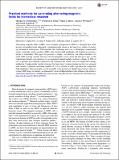| dc.contributor.author | Christiansen, Michael Gary | |
| dc.contributor.author | Bono, David C | |
| dc.contributor.author | Perreault, David J. | |
| dc.contributor.author | Anikeeva, Polina Olegovna | |
| dc.date.accessioned | 2019-07-17T18:23:26Z | |
| dc.date.available | 2019-07-17T18:23:26Z | |
| dc.date.issued | 2017-08 | |
| dc.date.submitted | 2017-04 | |
| dc.identifier.issn | 0034-6748 | |
| dc.identifier.issn | 1089-7623 | |
| dc.identifier.uri | https://hdl.handle.net/1721.1/121721 | |
| dc.description.abstract | Alternating magnetic fields (AMFs) cause magnetic nanoparticles (MNPs) to dissipate heat while leaving surrounding tissue unharmed, a mechanism that serves as the basis for a variety of emerging biomedical technologies. Unfortunately, the challenges and costs of developing experimental setups commonly used to produce AMFs with suitable field amplitudes and frequencies present a barrier to researchers. This paper first presents a simple, cost-effective, and robust alternative for small AMF working volumes that uses soft ferromagnetic cores to focus the flux into a gap. As the experimental length scale increases to accommodate animal models (working volumes of 100s of cm3 or greater), poor thermal conductivity and volumetrically scaled core losses render that strategy ineffective. Comparatively feasible strategies for these larger volumes instead use low loss resonant tank circuits to generate circulating currents of 1 kA or greater in order to produce the comparable field amplitudes. These principles can be extended to the problem of identifying practical routes for scaling AMF setups to humans, an infrequently acknowledged challenge that influences the extent to which many applications of MNPs may ever become clinically relevant. | en_US |
| dc.description.sponsorship | United States. Defense Advanced Research Projects Agency. ElectRx Program (No. HR001-15-C-0155) | en_US |
| dc.description.sponsorship | BRAIN Initiative (No. IR01MH111872-01) | en_US |
| dc.description.sponsorship | United States. Department of Defense. National Defense Science and Engineering Graduate (NDSEG) Fellowship | en_US |
| dc.language.iso | en | |
| dc.publisher | AIP Publishing | en_US |
| dc.relation.isversionof | 10.1063/1.4999358 | en_US |
| dc.rights | Article is made available in accordance with the publisher's policy and may be subject to US copyright law. Please refer to the publisher's site for terms of use. | en_US |
| dc.source | PMC | en_US |
| dc.title | Practical methods for generating alternating magnetic fields for biomedical research | en_US |
| dc.type | Article | en_US |
| dc.identifier.citation | Christiansen, Michael G., Christina M. Howe, David C. Bono, David Perreault and Polina Anikeeva. "Practical methods for generating alternating magnetic fields for biomedical research. Review of scientific instruments 88, 8 (August 2017) 084301 © 2017 Author(s). | en_US |
| dc.contributor.department | Massachusetts Institute of Technology. Department of Materials Science and Engineering | en_US |
| dc.contributor.department | Massachusetts Institute of Technology. Department of Electrical Engineering and Computer Science | en_US |
| dc.contributor.department | Massachusetts Institute of Technology. Department of Brain and Cognitive Sciences | en_US |
| dc.contributor.department | Massachusetts Institute of Technology. Research Laboratory of Electronics | en_US |
| dc.relation.journal | Review of scientific instruments | en_US |
| dc.eprint.version | Final published version | en_US |
| dc.type.uri | http://purl.org/eprint/type/JournalArticle | en_US |
| eprint.status | http://purl.org/eprint/status/PeerReviewed | en_US |
| dc.date.updated | 2019-07-01T14:46:02Z | |
| dspace.date.submission | 2019-07-01T14:46:17Z | |
| mit.journal.volume | 88 | en_US |
| mit.journal.issue | 8 | en_US |
